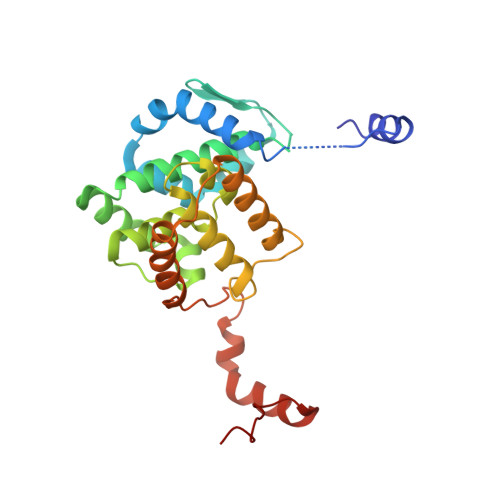Distinct Mechanism for the Formation of the Ribonucleoprotein Complex of Tomato Spotted Wilt Virus.
Guo, Y., Liu, B., Ding, Z., Li, G., Liu, M., Zhu, D., Sun, Y., Dong, S., Lou, Z.(2017) J Virol 91
- PubMed: 28904194
- DOI: https://doi.org/10.1128/JVI.00892-17
- Primary Citation of Related Structures:
5Y6J - PubMed Abstract:
The Tomato spotted wilt virus (TSWV) belongs to the Tospovirus genus of the Bunyaviridae family and represents the sole plant-infecting group within bunyavirus. TSWV encodes a nucleocapsid protein (N) which encapsidates the RNA genome to form a ribonucleoprotein complex (RNP). In addition, the N has multiple roles during the infection of plant cells. Here, we report the crystal structure of the full-length TSWV N. The N features a body domain consisting of an N-lobe and a C-lobe. These lobes clamp a positively charged groove which may constitute the RNA binding site. Furthermore, the body domains are flanked by N- and C-terminal arms which mediate homotypic interactions to the neighboring subunits, resulting in a ring-shaped N trimer. Interestingly, the C terminus of one protomer forms an additional interaction with the protomer of an adjacent trimer in the crystal, which may constitute a higher-order oligomerization contact. In this way, this study provides insights into the structure and trimeric assembly of TSWV N, which help to explain previous functional findings, but also suggests distinct N interactions within a higher-order RNP. IMPORTANCE TSWV is one of the most devastating plant pathogens that cause severe diseases in numerous agronomic and ornamental crops worldwide. TSWV is also the prototypic member of the Tospovirus genus, which is the sole group of plant-infecting viruses in the bunyavirus family. This study determined the structure of full-length TSWV N in an oligomeric state. The structural observations explain previously identified biological properties of TSWV N. Most importantly, the additional homotypic interaction between the C terminus of one protomer with another protomer indicates that there is a distinct mechanism of RNP formation in the bunyavirus family, thereby enhancing the current knowledge of negative-sense single-stranded RNA virus-encoded N. TSWV N is the last remaining representative N with an unknown structure in the bunyavirus family. Combined with previous studies, the structure of TSWV N helps to build a complete picture of the bunyavirus-encoded N family and reveals a close evolutionary relationship between orthobunyavirus, phlebovirus, hantavirus, and tospovirus.
Organizational Affiliation:
State Key Laboratory of Medicinal Chemical Biology and College of Pharmacy, Nankai University, Tianjin, China.














